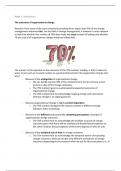Week 1: introduction
The outcomes of organizational change
Research from some of the most renowned consulting firms argues that 70% of the change
management initiatives fails. For the field of change management, it however is more relevant
to look into whether this number of 70% does make any sense instead of looking into whether
70 per cent of all organizations change initiatives indeed fails.
The answer to this question on the relevance of the 70% number, notably, is that it makes no
sense to put such an accurate number to a general phenomenon like organization change. But
why?
- Because of the ambiguities of organizational change
o We can hardly say that 70% of the initiatives fail if we do not have a clear
picture or idea of the change rationales.
o The 70% number ignores unanticipated/unexpected outcomes of
organizational change
o The 70% number fails to acknowledge ongoing change and improvision
whereas change is an ongoing process
- Because organizational change is highly context dependent
o The 70% number disregards the unique contexts of different change
initiatives when evaluating
- Because of the different and potentially competing perceptions of people of
organizational change outcomes
o The 70% number fails to acknowledge the multiple accounts of change
outcomes given that there will be satisfied and dissatisfied perceptions on
the same initiative (the perceptions of the event depend on who we ask)
- Because of the temporal role of time in change outcomes
o The 70% number fails to acknowledge the temporal nature of evaluating
change outcomes, while we can get very different evaluations of change
outcomes depending on the moment when we ask for this evaluations (i.e., if
, we get a negative evaluation if we ask to early. It however is very difficult to
determine what is the exact right time/moment to ask)
- Because of the measurability of organizational change outcomes
o The 70% number is an inherent quantitative number and therefore
downplays any form of qualitative evaluations, whereas incorporating
qualitative measures and features, that are difficult to quantify, may also be
important to reflect when evaluating the change outcomes (i.e., measuring
happiness or incorporating things under the radar).
So, what does all of this mean?
Important to take away form why change outcomes cannot be evaluated by statistics is that we
should not blindly follow numbers, but instead try to get the best evidence available, which is
called evidence-based management.
This evidence-based management is about making the best possible decisions through the
conscientious, explicit, and judicious use of the best available evidence from multiple sources in
order to increase the likelihood of a favorable outcome.
But how can we get to this evidence-based management?
1. Asking: first, we need to ask the right questions to translate a practical problem into
an answerable question
2. Acquiring: second, we need to systematically search for the evidence to acquire the
evidence
3. Appraising: third, we need to critically judge and evaluate the trustworthiness,
creditability and relevance of the evidence
4. Aggregating: fourth, we need to aggregate the evidence that we have by weighing
and puling together the evidence in order to determine what is the most important
and what is less important
5. Applying: fifth, we need to apply the evidence by incorporating it into the decision-
making process.
6. Assessing: last, we need to assess whether we were successful by evaluating the
decision-taken
,Differentiating within organizational change
In general, there are three ways to differentiate within the field of organizational change.
1. By the triggers for organizational change
First, we can differentiate within the field of change management by the forces that triggered
and drive organizational change. Here, two different types of factors are possible
1.1. External factors that drive organizational change
External forces stands for the forces that drive organizational change from outside the
unit/organization and are focused on developments within the following areas:
- Political developments
- Technological developments
- Cultural developments
- Demographic developments
- Economic developments
1.2. Internal factors that drive organizational change
Internal forces stands for the forces from inside the unit/department/organization and are
focused on developments within the organization itself such as:
- New technology
- New people in key positions (such as new CEO, new decision-makers etc. that have
new ideas and approaches in mind)
- Pressure to modify administrative structures
• Overlap between triggers*
Important to note, however, is that it often is very difficult to make a clear distinction between
whether external or internal drivers triggered the organizational change since they actually
tend to overlap. Yet, in most cases some forces seem to dominate more than others (i.e., covid
was a clear external driver) in terms of triggering the organizational change.
Additionally, important to keep in mind is that there are a lot of trend-following (adopting
fashions) behavior going on within organizational changes that increases the likelihood of
managers to benchmark towards what they perceive others do as a driver for change (copying).
, 2. By the scale of organizational change
Second, we can also differentiate within the field of change management between
evolutionary and revolutionary change that is based on the scale of the change. Important to
note that there are also other names known (discontinuous versus continuous or episodic vs
continuing flow etc.) for this distinction as summarized below:
3. By the source of organizational change
Third, another appropriate distinction that we make is whether the change emerged or was
planned that refers to the source and who was initiating the change:
- Top-down change process (planned change)
- Bottum up change process (emergent change)




